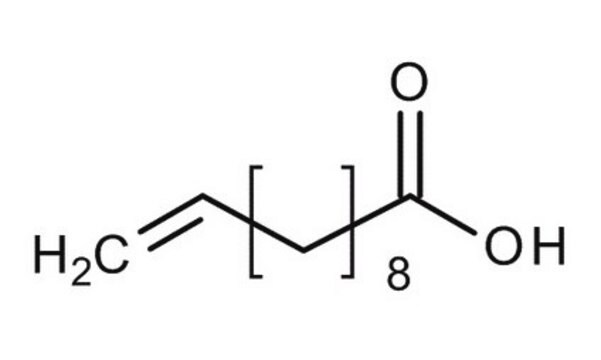W324721
Undecylenic acid
≥96%, FG
Synonyme(s) :
10-Undecenoic acid
About This Item
Halal
Kosher
Produits recommandés
Source biologique
synthetic
Niveau de qualité
Qualité
FG
Halal
Kosher
Conformité réglementaire
EU Regulation 1334/2008 & 178/2002
Essai
≥96%
Indice de réfraction
n20/D 1.449 (lit.)
pb
137 °C/2 mmHg (lit.)
Pf
23-25 °C (lit.)
Densité
0.912 g/mL at 25 °C (lit.)
Application(s)
flavors and fragrances
Documentation
see Safety & Documentation for available documents
Allergène alimentaire
no known allergens
Propriétés organoleptiques
woody; sweet
Chaîne SMILES
OC(=O)CCCCCCCCC=C
InChI
1S/C11H20O2/c1-2-3-4-5-6-7-8-9-10-11(12)13/h2H,1,3-10H2,(H,12,13)
Clé InChI
FRPZMMHWLSIFAZ-UHFFFAOYSA-N
Vous recherchez des produits similaires ? Visite Guide de comparaison des produits
Description générale
Application
- Emulsion Liquid Membranes Based on Os-NP/n-Decanol or n-Dodecanol Nanodispersions for p-Nitrophenol Reduction.: This study explores the use of emulsion liquid membranes incorporating undecylenic acid for the reduction of p-nitrophenol. The findings highlight the potential of these membranes in environmental applications, specifically in the removal of harmful organic compounds from water (Pîrțac et al., 2024).
- Retention behavior of nucleosides and nucleobases on a 3 μm undecylenic acid-functionalized silica column in per aqueous liquid chromatography and hydrophilic interaction liquid chromatography separation modes.: This article details the development of a novel undecylenic acid-functionalized silica column for improved separation of nucleosides and nucleobases. The column shows enhanced retention and selectivity, offering significant advancements in chromatographic techniques for biochemical analysis (Cheng et al., 2024).
Mention d'avertissement
Warning
Mentions de danger
Conseils de prudence
Classification des risques
Aquatic Chronic 3 - Eye Irrit. 2 - Skin Irrit. 2
Code de la classe de stockage
11 - Combustible Solids
Classe de danger pour l'eau (WGK)
WGK 1
Point d'éclair (°F)
300.2 °F - closed cup
Point d'éclair (°C)
149 °C - closed cup
Faites votre choix parmi les versions les plus récentes :
Déjà en possession de ce produit ?
Retrouvez la documentation relative aux produits que vous avez récemment achetés dans la Bibliothèque de documents.
Notre équipe de scientifiques dispose d'une expérience dans tous les secteurs de la recherche, notamment en sciences de la vie, science des matériaux, synthèse chimique, chromatographie, analyse et dans de nombreux autres domaines..
Contacter notre Service technique







